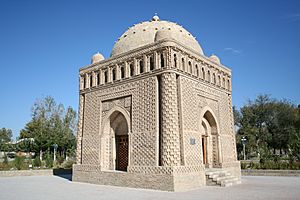Qubba facts for kids
A qubba is a special kind of building, usually a tomb or a shrine, found in Islamic architecture. It's known for its dome or a roof shaped like a pyramid. The word "qubba" comes from Arabic.
In many places, especially North Africa, a qubba is often the tomb of a local Muslim saint, called a wali or marabout. These buildings typically have a room covered by a dome or a pointed, pyramid-shaped roof.
What is a Qubba?
The Arabic word qubba first meant a tent made of animal hides. It also described anything gathered into a circular shape, like cloth. Later, this meaning grew to include domed buildings as they became common in Islamic architecture.
Today, qubba can also mean any tomb site that people visit for pilgrimage. In Turkish and Persian, similar words like kümbet or gunbād also mean a dome or a domed tomb.
How Qubbas Developed Over Time

One very famous domed building is the Dome of the Rock in Jerusalem. In Arabic, it's called Qubbat aṣ-Ṣakhra. However, this large building was quite unusual in early Islamic times.
At first, building fancy tombs to remember the dead was not common in Islamic culture. The prophet Muhammad himself was against such practices. But by the 700s, mausoleums (buildings for tombs) started to become popular. This was partly because Shi'a Muslims began building tombs for their leaders, called Imams. These tombs then became important places for religious ceremonies and visits.
The oldest surviving domed tomb in Islamic architecture is the Qubbat al-Sulaibiyya. It is in Samarra, Iraq, and dates back to the mid-800s. Building domed tombs became more common for both Shi'a and Sunni Muslims in the 900s. Early Sunni mausoleums were mostly built for political rulers. An example is the Samanid Mausoleum in Bukhara, Uzbekistan, built in the 900s.
Qubbas in Yazidism
Yazidi shrines and holy buildings often have cone-shaped spires. These spires are also known as qubbe in the Kurdish language.
See also
 In Spanish: Qubba para niños
In Spanish: Qubba para niños
- History of medieval Arabic and Western European domes
- Maqam (shrine)
- Mazar (mausoleum)
- Islamic pilgrimage
- Türbe
- Gonbad

